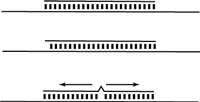Hybidization Technology
Renaturing Nucleic Acids
Blot
The situation is quite different from our discussion of hybridization kinetics.
First off, our target sequence is fixed to a solid support (the nylon filter).
This has a kind of interesting effect on the kinetics of hybrid formation.
The target DNA is a very small portionof the total genomic DNA on the filter
(for a 3000 bp fragment in the human genome it represents one millionth of the genome.
(approximately 10 picograms of 10 micrograms loaded in a lane)
But that 10 picograms is localized to a small band (or volume) on the filter
resulting in a high local concentration of target sequence.
The probe on the other hand, is very dilute in solution.
This results in the preferential hybridization of probe sequences to the filter bound target sequences rather than other probe sequences in solution.
As we discussed previously, the conditions we use for hybridization are designed to maximize the rate of hybrid formation. These conditions - high salt to minimize sugar-phosphate backbone repulstions and low temperature to maximize hybridization rate - allow mismatched hybrids to form.
Hybrids containing mismatched bases (non-complementary base pairs) are not as stable as perfectly matched hybrids because lack the H-bonds between the mismatched bases. In general
1% mismatch in a hybrid lowers its Tm by 1 oC
Under the conditions we normally use for hybridization, hybrids containing over 20% mismatched bases are allowed to form resulting in significant 'non-specific' binding (or background).
As we discussed, we remove these non-specific hybrids by washing under more stringent conditions - by adjusting the temperature and salt concentration of the wash buffer.
We divide these wash conditions into three broad classes:
High Stringent Wash - High Temperature, Low Salt.
These conditions select for nearly perfect hybrids as the conditions are very close to the Tm of a perfect match. Typically these conditions tolerate approximately 5% mismatch.
High stringency conditions are used to detect identical or very highly conserved genomic sequences complementary to the probe sequence.
Moderate Stringency Wash - High Temperature, High Salt
By keeping the salt concentration high, the repulsion between the sugar-phosphate backbones is reduced,. As a result, some mismatched hybrids are tolerated. Typically moderate stringency allows the detection of hybrids containing 10 - 20 % mismatched hybrids.
Moderate stringency conditions are useful in detecting genomic sequences that are 'related' to the probe sequence. These are typically cross-species hybridizations where limited sequence divergence is expected as function is expected to be conserved. Moderate stringency washes can also be useful in detecting related members of a gene family within a species.
Low Stringency Wash - Low Temperature, High Salt
This combination is uncomfortably similar to the conditions of hybridization itself.
Low stringency washes result in excessive non-specific background and specific hybrids burried in the background are difficult to resolve. Low stringency conditions may be useful in identifying or detecting highly diverged genomic sequences - but more often they are a waste of time. Other methods are better suited for these purposes (primarily PCR, which we will discuss later).
Start with the calculated Tm
Tm = 81.5 + 0.41 ( % GC ) + 16.6 log [ Na+ ]
for a genome containing 40% GC,
Tm = 81.5 + 0.41 (40) + 16.6 log [ Na+ ]
Tm = 81.5 + 16.4 + 16.6 log[ Na+ ]
Tm = 97.9 + 16.6 log [ Na+ ]
For High Stringency, [ Na+ ] = 0.01 M
Tm = 97.9 - 33.2
~ 65 oC.
Typically the wash temperature is about 60 - 65 degrees, allowing from 5 - 0 % mismatch.
For Moderate Stringency, the temperature remains the same but
the salt concentration is increased to 0.05M This shifts the Tm of the perfect hybrid to
Tm = 81.5 + 0.41 ( % GC ) + 16.6 log [ Na+ ]
= 97.9 - 27.5
= 76.3 oC
Since the temperature of the wash remains the same, these conditions will tolerate
( 76.5 - 60 ) to ( 76.5 - 65 )
16.5 to 11.5 % mismatch
In such probes, the mismatches are most likely to be scattered randomly along the length of the probe. Clustering of mismatches in one region of the probe can have more dramatic effects on hybrid stability.
This is more commonly a phenomenon encountered when using short probes (less than 50 nucleotides long). The Tm for such probes is calculated using the formula
Tm = 2 oC ( A + T ) + 4 oC ( G + C )
If a mismatched base is located at the end of the probe, the Tm decreases due to the loss of a single AT or GC base pair.
While H-bonds are relatively weak, the effect of many H-bonds between complementary sequences (the zipper effect) adds to the stability of the hybrid (Tm). A mismatch in the middle of a short probe has a big effect on the zipper effect, effectively dividing the lenght of the probe in half. The mismatched base acts as a nucleation center for denaturation, thus depressing the Tm more significantly than expected from the simple loss of an AT or GC pair.

Southern Blot